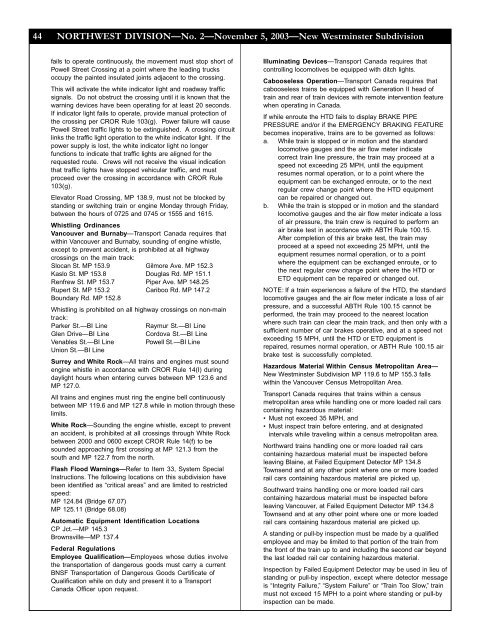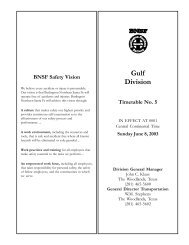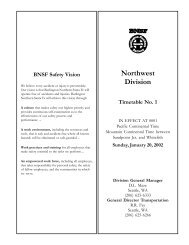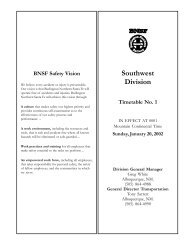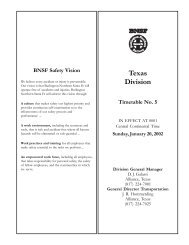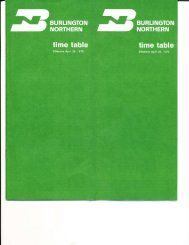2 11/5/03 - Friends of the Burlington Northern Railroad
2 11/5/03 - Friends of the Burlington Northern Railroad
2 11/5/03 - Friends of the Burlington Northern Railroad
Create successful ePaper yourself
Turn your PDF publications into a flip-book with our unique Google optimized e-Paper software.
44 NORTHWEST DIVISION—No. 2—November 5, 20<strong>03</strong>—New Westminster Subdivision<br />
fails to operate continuously, <strong>the</strong> movement must stop short <strong>of</strong><br />
Powell Street Crossing at a point where <strong>the</strong> leading trucks<br />
occupy <strong>the</strong> painted insulated joints adjacent to <strong>the</strong> crossing.<br />
This will activate <strong>the</strong> white indicator light and roadway traffic<br />
signals. Do not obstruct <strong>the</strong> crossing until it is known that <strong>the</strong><br />
warning devices have been operating for at least 20 seconds.<br />
If indicator light fails to operate, provide manual protection <strong>of</strong><br />
<strong>the</strong> crossing per CROR Rule 1<strong>03</strong>(g). Power failure will cause<br />
Powell Street traffic lights to be extinguished. A crossing circuit<br />
links <strong>the</strong> traffic light operation to <strong>the</strong> white indicator light. If <strong>the</strong><br />
power supply is lost, <strong>the</strong> white indicator light no longer<br />
functions to indicate that traffic lights are aligned for <strong>the</strong><br />
requested route. Crews will not receive <strong>the</strong> visual indication<br />
that traffic lights have stopped vehicular traffic, and must<br />
proceed over <strong>the</strong> crossing in accordance with CROR Rule<br />
1<strong>03</strong>(g).<br />
Elevator Road Crossing, MP 138.9, must not be blocked by<br />
standing or switching train or engine Monday through Friday,<br />
between <strong>the</strong> hours <strong>of</strong> 0725 and 0745 or 1555 and 1615.<br />
Whistling Ordinances<br />
Vancouver and Burnaby—Transport Canada requires that<br />
within Vancouver and Burnaby, sounding <strong>of</strong> engine whistle,<br />
except to prevent accident, is prohibited at all highway<br />
crossings on <strong>the</strong> main track:<br />
Slocan St. MP 153.9 Gilmore Ave. MP 152.3<br />
Kaslo St. MP 153.8 Douglas Rd. MP 151.1<br />
Renfrew St. MP 153.7 Piper Ave. MP 148.25<br />
Rupert St. MP 153.2 Cariboo Rd. MP 147.2<br />
Boundary Rd. MP 152.8<br />
Whistling is prohibited on all highway crossings on non-main<br />
track:<br />
Parker St.—BI Line<br />
Raymur St.—BI Line<br />
Glen Drive—BI Line<br />
Cordova St.—BI Line<br />
Venables St.—BI Line Powell St.—BI Line<br />
Union St.—BI Line<br />
Surrey and White Rock—All trains and engines must sound<br />
engine whistle in accordance with CROR Rule 14(I) during<br />
daylight hours when entering curves between MP 123.6 and<br />
MP 127.0.<br />
All trains and engines must ring <strong>the</strong> engine bell continuously<br />
between MP <strong>11</strong>9.6 and MP 127.8 while in motion through <strong>the</strong>se<br />
limits.<br />
White Rock—Sounding <strong>the</strong> engine whistle, except to prevent<br />
an accident, is prohibited at all crossings through White Rock<br />
between 2000 and 0600 except CROR Rule 14(f) to be<br />
sounded approaching first crossing at MP 121.3 from <strong>the</strong><br />
south and MP 122.7 from <strong>the</strong> north.<br />
Flash Flood Warnings—Refer to Item 33, System Special<br />
Instructions. The following locations on this subdivision have<br />
been identified as “critical areas” and are limited to restricted<br />
speed:<br />
MP 124.84 (Bridge 67.07)<br />
MP 125.<strong>11</strong> (Bridge 68.08)<br />
Automatic Equipment Identification Locations<br />
CP Jct.—MP 145.3<br />
Brownsville—MP 137.4<br />
Federal Regulations<br />
Employee Qualification—Employees whose duties involve<br />
<strong>the</strong> transportation <strong>of</strong> dangerous goods must carry a current<br />
BNSF Transportation <strong>of</strong> Dangerous Goods Certificate <strong>of</strong><br />
Qualification while on duty and present it to a Transport<br />
Canada Officer upon request.<br />
Illuminating Devices—Transport Canada requires that<br />
controlling locomotives be equipped with ditch lights.<br />
Cabooseless Operation—Transport Canada requires that<br />
cabooseless trains be equipped with Generation II head <strong>of</strong><br />
train and rear <strong>of</strong> train devices with remote intervention feature<br />
when operating in Canada.<br />
If while enroute <strong>the</strong> HTD fails to display BRAKE PIPE<br />
PRESSURE and/or if <strong>the</strong> EMERGENCY BRAKING FEATURE<br />
becomes inoperative, trains are to be governed as follows:<br />
a. While train is stopped or in motion and <strong>the</strong> standard<br />
locomotive gauges and <strong>the</strong> air flow meter indicate<br />
correct train line pressure, <strong>the</strong> train may proceed at a<br />
speed not exceeding 25 MPH, until <strong>the</strong> equipment<br />
resumes normal operation, or to a point where <strong>the</strong><br />
equipment can be exchanged enroute, or to <strong>the</strong> next<br />
regular crew change point where <strong>the</strong> HTD equipment<br />
can be repaired or changed out.<br />
b. While <strong>the</strong> train is stopped or in motion and <strong>the</strong> standard<br />
locomotive gauges and <strong>the</strong> air flow meter indicate a loss<br />
<strong>of</strong> air pressure, <strong>the</strong> train crew is required to perform an<br />
air brake test in accordance with ABTH Rule 100.15.<br />
After completion <strong>of</strong> this air brake test, <strong>the</strong> train may<br />
proceed at a speed not exceeding 25 MPH, until <strong>the</strong><br />
equipment resumes normal operation, or to a point<br />
where <strong>the</strong> equipment can be exchanged enroute, or to<br />
<strong>the</strong> next regular crew change point where <strong>the</strong> HTD or<br />
ETD equipment can be repaired or changed out.<br />
NOTE: If a train experiences a failure <strong>of</strong> <strong>the</strong> HTD, <strong>the</strong> standard<br />
locomotive gauges and <strong>the</strong> air flow meter indicate a loss <strong>of</strong> air<br />
pressure, and a successful ABTH Rule 100.15 cannot be<br />
performed, <strong>the</strong> train may proceed to <strong>the</strong> nearest location<br />
where such train can clear <strong>the</strong> main track, and <strong>the</strong>n only with a<br />
sufficient number <strong>of</strong> car brakes operative, and at a speed not<br />
exceeding 15 MPH, until <strong>the</strong> HTD or ETD equipment is<br />
repaired, resumes normal operation, or ABTH Rule 100.15 air<br />
brake test is successfully completed.<br />
Hazardous Material Within Census Metropolitan Area—<br />
New Westminster Subdivision MP <strong>11</strong>9.6 to MP 155.3 falls<br />
within <strong>the</strong> Vancouver Census Metropolitan Area.<br />
Transport Canada requires that trains within a census<br />
metropolitan area while handling one or more loaded rail cars<br />
containing hazardous material:<br />
• Must not exceed 35 MPH, and<br />
• Must inspect train before entering, and at designated<br />
intervals while traveling within a census metropolitan area.<br />
Northward trains handling one or more loaded rail cars<br />
containing hazardous material must be inspected before<br />
leaving Blaine, at Failed Equipment Detector MP 134.8<br />
Townsend and at any o<strong>the</strong>r point where one or more loaded<br />
rail cars containing hazardous material are picked up.<br />
Southward trains handling one or more loaded rail cars<br />
containing hazardous material must be inspected before<br />
leaving Vancouver, at Failed Equipment Detector MP 134.8<br />
Townsend and at any o<strong>the</strong>r point where one or more loaded<br />
rail cars containing hazardous material are picked up.<br />
A standing or pull-by inspection must be made by a qualified<br />
employee and may be limited to that portion <strong>of</strong> <strong>the</strong> train from<br />
<strong>the</strong> front <strong>of</strong> <strong>the</strong> train up to and including <strong>the</strong> second car beyond<br />
<strong>the</strong> last loaded rail car containing hazardous material.<br />
Inspection by Failed Equipment Detector may be used in lieu <strong>of</strong><br />
standing or pull-by inspection, except where detector message<br />
is “Integrity Failure,” “System Failure” or “Train Too Slow,” train<br />
must not exceed 15 MPH to a point where standing or pull-by<br />
inspection can be made.


